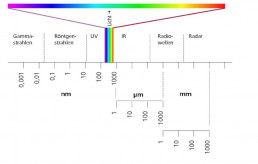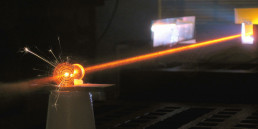Due to its physical properties, such as good beam quality and good focusability, laser radiation has a high risk potential primarily for the eyes. For this reason, special optical filters are used as laser safety eyewear or laser safety windows to protect the eyes.
Since each laser, depending on its active medium and its structure, can emit at least one, but under certain circumstances also several specific wavelengths, filters are required that are adapted to the wavelength and power of the laser source in question. Ideally, these filters transmit as much “normal” light as possible, i.e. visible light, and block the laser wavelengths completely. Why do we need laser protection for our eyes? In this blog article we will explain why laser safety is so important.
Why is laser radiation dangerous?
The ‘light’ from powerful lasers can be concentrated to power densities (power per area or watts/cm2) that are high enough to evaporate tissue, metal or ceramics. In the medical field laser radiation is used to remove tattoos or to cut human tissue. These examples show a range of applications which require high power lasers and as such there is a high potential risk of accidental illumination of the user.

Because the eyes are much more sensitive to light they are at increased risk. In fact, it is possible to cause irreversible ocular injury with just one glance into a direct or reflected laser beam even at lower power output levels.
Physical background
Wave trains of any given laser radiation have a fixed relation in time and space (coherent) and are all of nearly the same wavelength (monochromatic). Laser light can travel over great distances as a nearly parallel beam (collimated). All of this means that the power that can impact an area such as the eye is independent of the distance to the radiation source. Imagine a laser pointer with a beam spot that remains about the same size over great distances. If you compare a thermal source of radiation like a light bulb with a laser you will observe several differences.
The light bulb emits light over a very broad spectrum of wavelengths with no specific direction of emission. The power of the bulb that may reach the eye decreases with distance because the bulb emits in all directions (see picture). When comparing a light bulb with a laser, both emitting 1 W optical power, and if there is a 1 meter distance between our eyes and the light source, then the quantity of light coming from the laser and reaching the eye is a factor of 100,000 higher compared to the light quantity from the bulb (this assumes a normally dilated pupil diameter of 7 mm – i.e. eyes adapted to darkness).
Effects of laser radiation on the eye
In addition to the quantity of light that can hit the eye the high focus ability of the coherent laser light is another danger. While the bulb creates an image on the retina of approximately 100 μm, the laser light is reduced to a spot of just a few micrometers (~ 10 μm) in diameter. A physicist would say that the bulb produces incoherent light, but due to the coherence of the laser light the laser power which hits the eye is concentrated on a much smaller spot. The power density (power per area or watts/cm2) resulting from this concentration may be sufficiently high, so that any tissue in the focus will be heated up and very quickly destroyed. Since the fovea (responsible for sharp vision and located on the retina) also has a size of only a few micrometers, it is possible to lose one’s eyesight by one single laser pulse.

laservision – Competence and quality
laservision has been wholly-owned by the uvex safety group since 2004, complementing their programme for personal protective equipment with innovative laser protection products perfectly. In addition to laser safety eyewear, the product range includes laser protection filters and windows, as well as large area protection for different applications. Since 2006, the company is successfully serving markets in the USA, Canada and parts of Asia through laservision USA. laservision’s target groups comprise manufacturers as well as users of laser technology in fields such as industry, medicine, research and defence.
The philosophy of our brand is to provide optimum laser safety protection for all lasers worldwide in accordance with the standards. This is based on our intensive research, manufacturing competence in our own plants, close collaboration with high-performance suppliers and the transfer of expertise within the uvex safety group. This ensures laservision’s technological excellence on a long lasting basis.